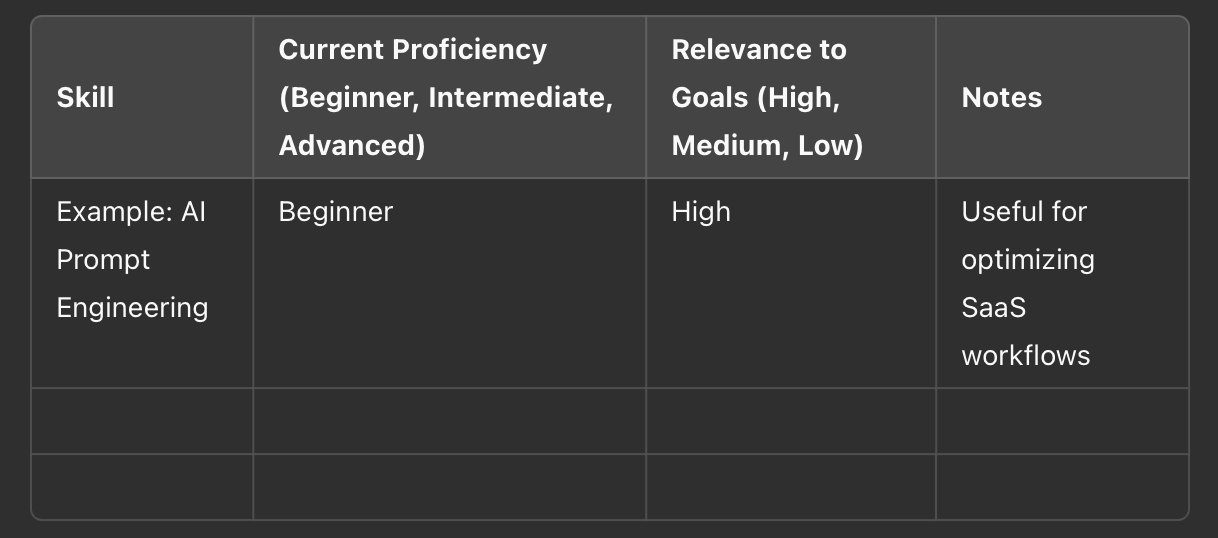Your Personal Skill Audit Tool
Ready to take control of your skill development? Download our free Skill Audit Template and start your personal skill audit today.
In a world where the performance bar is always rising—and AI advancements redefine what it means to be “highly skilled” almost overnight—staying competitive demands more than just keeping up. It requires strategic reinvention.
Gone are the days when skills could remain static for years. Today, what qualified as “expertise” just a few months ago might now be table stakes. The question isn’t whether you need to grow, but where to focus for maximum leverage.
That’s where the Priority Matrix comes in—a dynamic tool to audit, prioritize, and master the skills that align with today’s (and tomorrow’s) demands.
What is the Personal Skill Audit Tool?
The Priority Matrix is a framework that helps you assess and prioritize skills based on two key factors:
Impact: How much will this skill improve your life or career?
Effort: How much time, energy, and resources will it take to develop this skill?
By mapping skills on a 2x2 grid, you can visually identify which skills are worth investing in right now, which ones to plan for later, and which ones to deprioritize.
Step 1: Skill Evaluation Template
Before you can prioritize, you need to evaluate your current skills and identify gaps. Use this simple template to audit your skills:
Step 2: Impact vs Effort Assessment
Once you’ve identified your skills, it’s time to prioritize them using the Priority Matrix. Here’s how:
High Impact, Low Effort (Quick Wins): These are the skills that will give you the most bang for your buck. Focus on these first.
Example: Learning basic AI prompting to improve your SaaS workflows.
High Impact, High Effort (Major Projects): These skills are worth investing in but require more time and resources. Plan these for the medium to long term.
Example: Mastering data analysis to make data-driven decisions for your business.
Low Impact, Low Effort (Fill-Ins): These skills are nice to have but won’t move the needle much. Tackle them when you have spare time.
Example: Improving your email formatting skills.
Low Impact, High Effort (Time Sinks): Avoid these skills unless they become critical in the future.
Example: Learning a niche programming language that’s not relevant to your goals.
Step 3: 90-Day Skill Development Planner
Now that you’ve prioritized your skills, it’s time to create a actionable plan. Here’s a 90-day framework to help you stay on track:
Month 1: Focus on Quick Wins
Identify 1-2 high-impact, low-effort skills.
Dedicate 30-60 minutes daily to learning and practicing.
Example: Spend 30 minutes daily learning AI prompting techniques.
Month 2: Start a Major Project
Choose one high-impact, high-effort skill to work on.
Break it into smaller milestones.
Example: Complete an online course on data analysis and apply it to your business metrics.
Month 3: Consolidate and Reflect
Review your progress on quick wins and major projects.
Adjust your plan based on what’s working and what’s not.
Example: If AI prompting has significantly improved your productivity, consider diving deeper into advanced techniques.
Why This Works for Me
I’m constantly juggling multiple responsibilities—building my business, managing clients, and staying on top of industry trends. The Personal Skill Audit Tool helps me cut through the noise and focus on the skills that will drive real results.
By using this tool, I’ll not only improve my own capabilities but also model effective skill development for my clients. It’s a win-win!
Your Turn: Build Your Priority Matrix
Ready to take control of your skill development? Download our free Skill Audit Template and start your personal skill audit today.
Remember, growth is a journey, not a destination. With the right tools and a clear plan, you’ll be amazed at how much you can achieve in just 90 days.
What’s one skill you’re prioritizing this quarter? Share in the comments below!




